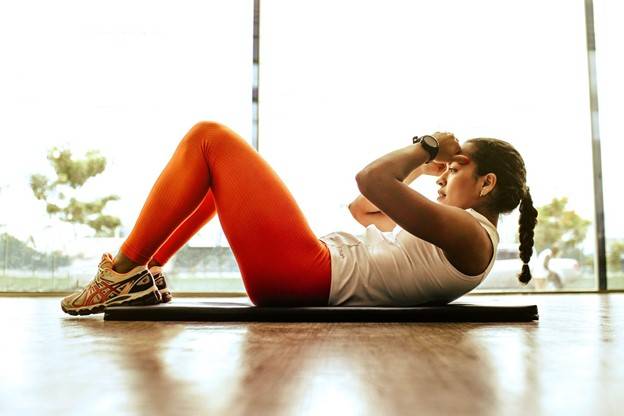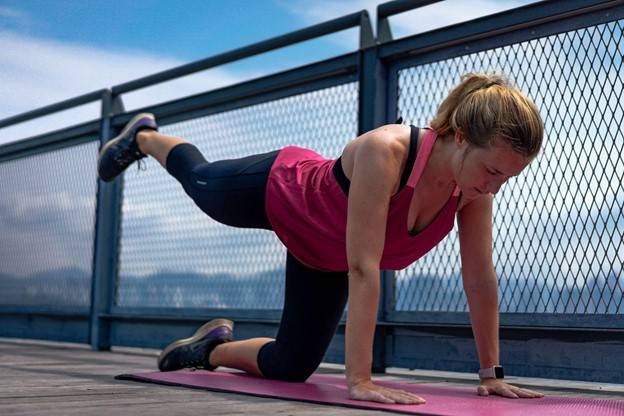Can't Hit the Gym? Here's How HIIT Can Keep You Fit at Home

October 2021. This article is independently written by Fusion 360. All opinions given are the opinion of Fusion 360

HIIT, or high-intensity interval training, began in the 1970s with Nautilus founder Arthur Jones. The idea was to spend less time at the gym while reaping all the benefits of a complete workout. HIIT involves bouts of high-intensity exercise- like burpees, jumping jacks, jump squats, etc., followed by shorter recovery times.
A while later—in 1996—a Japanese doctor named Dr. Izumi Tabata started studying how to improve the Japanese speed skating team's performance. The Tabata method resulted in athletes doing 20 seconds of a high-intensity exercise followed by 10 seconds of rest, repeated four times in a row.
Both types of interval training rely on the same principles and have surprisingly good results in physical fitness.
Many people find it hard to get to the gym regularly. A few of the justifications might sound familiar—not enough money to pay for a gym membership or lack of energy are the two most prevalent. If you find it hard to get to the gym, you may want to consider adding some at-home HIIT exercises to your day.
HIIT Benefits
In addition to being convenient, HIIT also has many fantastic health benefits.
The average person does not need to train like a marathon runner but incorporating all three types of intensities is the most efficient way to increase intensity and workout gains.
-
It burns a lot of calories in a short period. HIIT burns 25-30% more calories than running, biking, and weight training in the same amount of time. If you follow a strict CICO (calories in calories out) weight loss program, then HIIT will give you the most calories burned for time spent.
-
Boosts your metabolism. Interval training increases the fat and carbohydrate metabolic processes in the body for hours after you exercise. For example, one study showed that two minutes of HIIT sprints increased the metabolism as much as 30 minutes of running over 24 hours. This means that the body burns through the calories you eat faster. It also helps your body burn stored fat for energy instead of carbohydrates.
-
Helps you lose weight. The combination of boosting your metabolism and increasing the number of calories burned can have cumulative effects over time. When used regularly, HIIT can help you lose fat and weight circumference.
-
Improves endurance. Perhaps one of the best benefits of HIIT exercise is its effect on oxygen consumption. Endurance training improves your body's ability to process and use oxygen. Typically, you would need to do regular cardio to improve overall endurance. With HIIT, you can get the same results in half the time.
- Reduces blood pressure in people who are obese or overweight. HIIT is not only more accessible but can reduce heart rate and lower blood pressure in practitioners with obesity.
Even if you go to the gym regularly, you may want to consider adding a day of HIIT to your workout routine to maximize fitness gains. Its benefit to time spent ratio is only part of what makes interval training popular.
How To HIIT
HIIT exercises use bodyweight, resistance bands, free weights, medicine balls, or weight machines.
Over 10-30 minutes, the participant does several rounds of high-intensity exercises followed immediately by a short rest period. Several activities are grouped together, and a longer rest period is included between groups.
The amount of time you do for each exercise can vary, but typically it's between 20 seconds and 1 minute. Therefore, the rest time should be about half the time you do the exercise.
Over 10-30 minutes, the participant does several rounds of high-intensity exercises followed immediately by a short rest period. Several activities are grouped together, and a longer rest period is included between groups.
The amount of time you do for each exercise can vary, but typically it's between 20 seconds and 1 minute. Therefore, the rest time should be about half the time you do the exercise.
There are two main types of rest days: active and passive. Active rest involves low-impact, low-intensity activity, while passive rest means taking the whole day off from exercise.
For, example:
- 20 sec of squats, 10-sec rest
- 20-sec burpees, 10-sec rest
- 20-sec alternating lunges, 10-sec rest
- 20-sec jump rope, 10-sec rest
- Repeat x 4-6 times
- Rest 1 minute between sets
One of the best aspects of HIIT workouts is that they are 100 percent customizable. HIIT is accessible if you are injured, overweight, or obese. You simply need to modify the workouts to suit your body.
Basic HIIT Exercises
There are a few things you should know to make your ideal HIIT home exercise routine.
Try to incorporate as many full-body exercises as possible. Not only do they work upper and lower body muscles simultaneously, but they are the muscles you use every single day to walk, carry groceries, get dressed, etc.
If you want to formulate a workout that targets specific muscle groups (i.e., arms, legs, or abs), be sure you work front, back, and side to create balance in the body. For example, do not spend weeks working on your quads (front of the leg) and forget about the hamstrings (back of the leg). Muscles imbalances tend to cause problems reasonably quickly if not addressed.
Try to incorporate as many full-body exercises as possible. Not only do they work upper and lower body muscles simultaneously, but they are the muscles you use every single day to walk, carry groceries, get dressed, etc.
If you want to formulate a workout that targets specific muscle groups (i.e., arms, legs, or abs), be sure you work front, back, and side to create balance in the body. For example, do not spend weeks working on your quads (front of the leg) and forget about the hamstrings (back of the leg). Muscles imbalances tend to cause problems reasonably quickly if not addressed.

Here are a few basic, equipment-free exercises that you can turn into your very own HIIT routine.
Full Body
- Squats
- Burpees
- Jumping Jacks
- Jump Squats
- High Knees
- Mountain climbers
Arms
- Push-ups (regular, wide-armed)
- Triceps Dips
- Plank Jack Push-Ups
Legs
- Alternating Jump Lunges
- Side Lunges
- Skaters
- Donkey Kicks
- Curtsy Lunges
- Bridges
- Warrior III (Single-leg toe touch)
Abs
- Crunches
- V-ups
- Plank
- Side plank
- Russian twists
- Dead bugs
Put the exercises into groups of four. Try to do two full-body exercises per group and mix in a couple of area-specific exercises.
For example:
- Burpees (full body)
- Push-ups (arms)
- Squats (full body)
- Dead bugs (abs)
One set will take about ten minutes to complete. Do one to three sets every day for maximum benefits!
HIIT For Everyone
The HIIT at home phenomena’s greatest accomplishment is making home workouts accessible for anyone. If you doubt your ability to make your own HIIT workout (and you shouldn’t) or feel like you want a little extra motivation, you can always find inspiration online. The only way to know if a workout will work for your body is to try it out!
It's important to always consult your physician before making changes to your current workout routine. A professional personal trainer can be of great help too.
And don’t forget your Kailo pain patch before or after every workout! Patients report near-instant pain relief, and pain management experts theorize that it works through your body’s natural electrical systems as it communicates with the brain. Try it and see the results for yourself!
Sources:
https://pubmed.ncbi.nlm.nih.gov/17267731/
https://pubmed.ncbi.nlm.nih.gov/25162652/
https://pubmed.ncbi.nlm.nih.gov/22710610/
https://pubmed.ncbi.nlm.nih.gov/28401638/
https://pubmed.ncbi.nlm.nih.gov/27368057/
It's important to always consult your physician before making changes to your current workout routine. A professional personal trainer can be of great help too.
And don’t forget your Kailo pain patch before or after every workout! Patients report near-instant pain relief, and pain management experts theorize that it works through your body’s natural electrical systems as it communicates with the brain. Try it and see the results for yourself!
Sources:
https://pubmed.ncbi.nlm.nih.gov/17267731/
https://pubmed.ncbi.nlm.nih.gov/25162652/
https://pubmed.ncbi.nlm.nih.gov/22710610/
https://pubmed.ncbi.nlm.nih.gov/28401638/
https://pubmed.ncbi.nlm.nih.gov/27368057/






